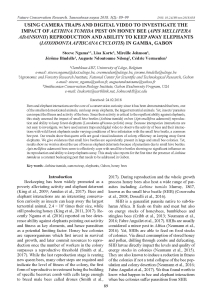Ngama S., Korte L., Johnson M., Bindelle J., Ndoutoume A., Vermeulen C.
Bees and elephant interactions are the core of a conservation curiosity since it has been demonstrated that bees, one of the smallest domesticated animals, can keep away elephants, the largest terrestrial animals. Yet, insects’ parasites can impact the fitness and activity of the bees. Since their activity is critical to the repellent ability against elephants, this study assessed the impact of small hive beetles (Aethina tumida) on bee (Apis mellifera adansonii) reproduction and ability to keep forest elephants (Loxodonta africana cyclotis) away. Because interspecies interactions are not easy to investigate, we have used camera traps and digital video to observe the activity of bees and their interactions with wild forest elephants under varying conditions of hive infestation with the small hive beetle, a common bee pest. Our results show that queen cells are good visual indicators of colony efficiency on keeping away forest elephants. We give evidences that small hive beetles are equivalently present in large and small bee colonies. Yet, results show no worries about the use of bees as elephant deterrents because of parasitism due to small hive beetles. Apis mellifera adansonii bees seem to effectively cope with small hive beetles showing no significant influence on its reproduction and ability to keep elephants away. This study also reports for the first time the presence of Aethina tumida as a constant beekeeping pest that needs to be addressed in Gabon.
Consultez la notice complète de l’article sur ORBi

